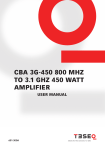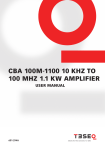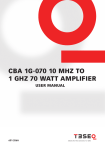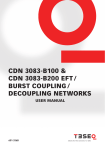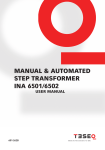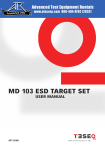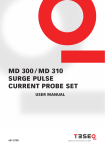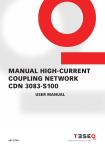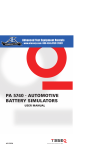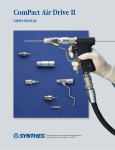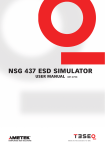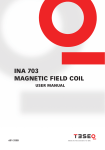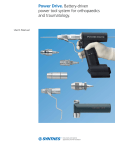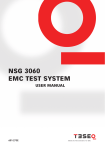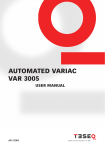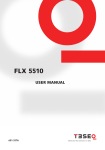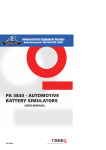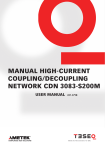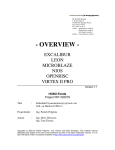Download CDN 117 118 User Manual english.indd
Transcript
® E stablished 1981 Advanced Test Equipment Rentals www.atecorp.com 800-404-ATEC (2832) 1 CDN 117/117-M CDN 118/118-M Signal & data line coupling networks User Manual 601-142K CDN 117/117-M CDN 118/118-M Signal & data line coupling networks User Manual CDN 117/117-M CDN 118/118-M Signal & data line coupling networks contentS 1General 1.1Safety 1.2 Safety measures 1.3Installation 1.4 Test execution 2 Functional description 2.1 CDN 117 2.2 CDN 118 3 Test setups 3.1Connections 3.1.1 Coupling modes with differential working generators 3.2 Setup for unshielded interconnection lines with 1.2/50 µs pulse 3.2.1 Coupling setup with 1.2/50 µs pulse 3.3 Test setup for unshielded unsymmetrically operated lines with 1.2/50 µs pulse 3.3.1 Coupling into CDN 117 3.4 Test setup for unshielded symmetrically operated lines with 1.2/50 µs or 10/700 µs pulse 3.4.1 Coupling CDN 118 4 Technical specifications 4.1Dimensions 4.2 Environmental conditions 4.3 Coupling assembly check list 5Maintenance 5.1Warranty 6Addresses 5 5 6 7 8 9 9 11 13 13 14 14 14 16 16 17 17 19 21 21 22 23 23 24 1General The CDN 117 and CDN 118 coupling - decoupling networks provide a means for injecting standards-compliant surge pulses into signal and datalines, as well as telecom lines. These networks are used in combination with surge generators. Tests can be performed on equipment, assemblies and installations while they are in operation. These tests and their required coupling methods are prescribed in various test standards (e.g. IEC/EN 61000-6-2, IEC/EN 61000-4-5). Specifications and recommendations regarding the execution of the tests, and their severity, the permissible reaction by the equipment under test (EUT), etc. can be found in the relevant standards. The coupling networks with the suffix -M are shipped with a pair of cables that fit Teseq’s NSG 3000 family generator or Modula. Otherwise, they are identical to the base models. 1.1 Safety The CDN 117 and CDN 118 coupling - decoupling networks are designed for operation with high voltage generators, which contain high energy levels. Incorrect or careless operation can be lethal! The following safety measures must be strictly and responsibly observed at all times. Users must also comply with all safety advice that is provided with generators that are used with the CDN 117 and CDN 118. 5 6 Neither Teseq AG, Luterbach, Switzerland nor its associated sales organizations accept any responsibility for personal injury or for any material or consequential damage resulting from negligent operation of this equipment. These instruments have been designed in conformity with the relevant safety regulations and provide all the necessary requirements for safe and reliable operation. 1.2 Safety measures These operating instructions form an integral part of the equipment and must be carefully studied before putting the equipment into operation and must be available to the user at all times. WARNING - The equipment must only be used by trained personnel. Personnel fitted with a heart pacemaker must neither operate the equipment nor remain in the test vicinity when the generator is in operation. These instruments are not designed for use in an explosive atmosphere. The test equipment is to be set up in conformity with the relevant safety standards (e.g. VDE 104). The coupling network housing must be properly grounded (earthed). To ensure safe operation, only approved accessories, plugs, adapters, etc. are to be used. The setup must offer insulation protection against voltage which is at least equal to the pulse voltage. The pulse voltage must not be able to find its way to ungrounded metallic objects even if the EUT is faulty or fails. CDN 117/117-M CDN 118/118-M Signal & data line coupling networks Depending on the type of EUT and especially on its cabling, a considerable amount of interference can be radiated which could affect nearby systems and radio communication. These environmental interference effects to be controlled by the user through the use of suitable measures such as a Faraday cage, shielded cable runs, etc. 1.3 Installation Since the CDN 117 and CDN 118 do not have their own power supplies, they have not been assigned a protection class. However, they are typically operated according to protection class 1 in view of their electrical connection to pulse generators and the metallic parts of their casing. Local installation regulations must be respected to ensure the safe flow of leakage currents. WARNING - Operation without a ground (protective earth) connection is forbidden! Operate the equipment only in dry surroundings. Any condensation that occurs must be allowed to evaporate before putting the equipment into operation. Do not exceed the permissible ambient temperature, humidity or altitude. Ensure that a reliable return path for the interference current is provided between the EUT and the generator. The reference ground plane and the ground connections to the instruments that are described in the relevant test standard will serve this purpose well. These instruments should be opened only by a qualified specialist if specifically instructed to do so in the operating manual. 7 8 1.4 Test execution The test area must be organized so that no unauthorized persons have access during execution of a test. If a safety contact (interlock) is used as a means of access control to the test area (e.g. Faraday cage), then an additional contact in series with any hazardous voltages or currents is necessary to provide protection for parts of the EUT that are in danger of being touched. EUTs, together with their accessories and cables, are to be considered live during a test. The test generator must be stopped and the EUT supply interrupted before any work can be performed on the EUT. This can often be achieved by opening the interlock circuit, depending on the type of generator in use. The EUT is to be tested only in a protective cage or under a hood which provides protection against electric shock and all manner of other dangers pertaining to the particular EUT. The safety instructions for all instruments and associated equipment in the test setup are to be observed. The configuration of the test setup is to be strictly in compliance with the methods described in the relevant standard to ensure that the test is executed in a compliant manner. CDN 117/117-M CDN 118/118-M Signal & data line coupling networks 2 FUNCTIONAL DESCRIPTION The CDN 117 and CDN 118 coupling - decoupling networks, together with their accessories, provide a means to inject standardized surge pulses into signal, data and/or telecom lines. These coupling networks can be used in situations where the inputs and outputs of mains-free connection lines must be tested for interference immunity. The CDN 117 and 118 are designed to be used in conjunction with a surge pulse generator. They enable tests to be performed on equipment or systems while they are in operation, by eliminating the attenuation of the surge pulse by auxiliary equipment (AE). The AE must usually be protected by surge suppressors against the effects of excessively high residual currents. Relevant tests and coupling methods are described in the test standards IEC/EN 61000-6-1, IEC/ EN 61000-6-2, IEC/EN 61000-4-5, etc. 2.1 CDN 117 The versatile CDN 117 can be used on either unscreened (or unshielded), unsymmetrically driven signal lines as well as on unscreened signal and data lines. The network enables symmetric (line to line) and asymmetric (line to ground) coupling of 1.2/50 µs hybrid pulses into pairs of conductors. The test pulse is inductively decoupled from the input side of the CDN (AE terminals) so that the surge pulse is coupled as fully as possible to the EUT via the output terminals. The integral 40 Ω series resistors raise the source impedance of the pulse generator to 40 Ω. (Since the 2 Ω output impedance of the generator is a complex quantity, the combined value of the generator plus 40 Ω lies closer to the required value of 40 Ω). 9 10 Several CDN 117s can be arranged in parallel for applications where more than two conductors must be decoupled. A special coupling cable is needed. DC decoupling must be achieved with a coupler type INA 170, INA 171 or INA 174. The coupling mode can be changed by relocating the connecting cable from the pulse generator. 1.6 AT 20 mH A in 40 Ω A’ PE PE 1.6 AT 20 mH B 40 Ω out B’ Functional schematic of the CDN 117 INA 170 The INA 170 contains a coupling spark gap without a capacitor. The spark gap has a trigger voltage of 90 V. The coupling element is used for signal lines with a frequency of over 5 kHz. INA 171 The INA 171 contains a coupling spark gap with a 0.1 µF capacitor in parallel. The spark gap has a trigger voltage of 90 V. The coupling element is used for signal lines with a frequency of under 5 kHz. INA 174 The INA 174 contains a 0.5 µF capacitor that can be connected in series with the 40 Ω already incorporated in the coupling network. This type of coupling element is used for capacitive injection into unscreened signal and data lines. CDN 117/117-M CDN 118/118-M Signal & data line coupling networks 2.2 CDN 118 This device is used on unscreened or unshielded, symmetrically driven telecommunication lines. The network enables symmetric (line to line) and asymmetrical (line to ground) coupling of 1.2/50 and 10/700 µs pulses into pairs of conductors. The test pulse is inductively decoupled from the input side of the CDN (AE terminals) so that surge pulse is coupled as fully as possible to the EUT. A high value decoupling choke is required due to the large voltage-time characteristic of the 10/700 µs pulse. The requisite 100/160 Ω series resistors are arranged in the INA 172 - INA 175 series so that all required modes can be achieved by proper connection of the INA 370 cable. DC decoupling can be performed by using either the INA 170 or INA 171 coupling device. L1’ L1 A’ in L2’ L2 PE B’ PE L3’ L3 C’ L4’ L4 D’ Functional schematic of the CDN 118 out 11 12 INA 172 This device contains four 100 Ω, 6 W resistors mounted in aplastic housing equipped with the necessary connectors to achieve all coupling modes in conjunction with a CDN 118. It is to be used only with the CDN 118. R = 4 x 100 Ω A B C D Functional schematic of the INA 172 INA 170 The INA 170 contains a coupling spark gap without a capacitor. The spark gap has a trigger voltage of 90 V. The coupling element is used for signal lines with a frequency of over 5 kHz. INA 171 The INA 171 contains a coupling spark gap with a 0.1 µF capacitor in parallel. The spark gap has a trigger voltage of 90 V. The coupling element is used for signal lines with a frequency of under 5 kHz. INA 173 The INA 173 is a short circuit connector to connect a line to ground. INA 175 This device contains four rugged 160 Ω, 6 W resistors mounted in a plastic housing equipped with the necessary connectors to achieve all coupling modes in conjunction with a CDN 118. It is to be used only with the CDN 118. CDN 117/117-M CDN 118/118-M Signal & data line coupling networks 3TEST SETUPS Each test setup should be carefully planned. All the equipment should be securely positioned, and all cables should be securely connected. The safety advice given in Sections 1 and 2 and in the generator manual must be observed. The EUT and the wiring should be handled only when the generator is not active. Various test setups and test methods are possible. The following sections provide examples with more precise details. 3.1 Connections There are two black safety laboratory sockets on the top left of the CDN 117. Both lines (L1 and L2) are marked as input and each is protected by a 1.6 A fuse. These input sockets share a common ground point which is internally and permanently connected to the housing of the coupling network. The signal or data lines from auxiliary equipment or loads, such as sensors, detectors, converters, temperature probes, switching elements, etc., are connected to these line inputs. The output (out), to which the EUT must be connected, is positioned on the right hand side. The EUT could be, a computer, any type of signal amplifier, an evaluation device or a general type of central system controller. The common ground socket is connected to the housing. The pulse connections from the generator are plugged into two of the five high voltage sockets to obtain the required type of coupling. 13 14 3.1.1 Coupling modes with differential generators Symmetrical coupling can only be achieved with generators with floating output. The connection of the coupling network to the high (+) and low (-) outputs of the generators are shown in the following diagrams. 3.2 Setup for unshielded interconnection lines with 1.2/50 µs pulse 3.2.1 Coupling setup with 1.2/50 µs pulse Generator 1.2/50 µs pulse Auxilliary equipment INA 174 L1 IN Peripherie L2 1.6 AT 20 mH CDN 117 1.6 AT 20 mH Equipment under test EUT 40 Ω 40 Ω OUT Prüfling Line to line coupling, line L1 à L2 If the coupling is changed from L2 à L1, then the polarity from the generator can be swapped. CDN 117/117-M CDN 118/118-M Signal & data line coupling networks Generator 1.2/50 µs pulse Auxilliary equipment INA 174 L1 IN Peripherie 15 L2 1.6 AT 20 mH CDN 117 1.6 AT 20 mH Equipment under test EUT 40 Ω 40 Ω OUT Prüfling Line to ground coupling, line L1 à PE Generator 1.2/50 µs pulse Auxilliary equipment L1 IN Peripherie L2 INA 174 1.6 AT 20 mH CDN 117 1.6 AT 20 mH Line to ground coupling, line L2 à PE Equipment under test EUT 40 Ω 40 Ω OUT Prüfling 16 3.3 Test setup for unshielded asymmetrically operated lines with 1.2/50 µs pulse 3.3.1 Coupling CDN 117 Generator 1.2/50 µs pulse INA 170/171 Auxilliary equipment L1 IN Peripherie L2 1.6 AT 20 mH CDN 117 1.6 AT 20 mH Equipment under test EUT 40 Ω 40 Ω OUT Prüfling Line to line coupling with 1.2/50 µs pulse on line L1 à L2 Generator 1.2/50 µs pulse INA 170/171 Auxilliary equipment L1 IN Peripherie L2 1.6 AT 20 mH CDN 117 1.6 AT 20 mH Equipment under test EUT 40 Ω 40 Ω OUT Prüfling Line to ground coupling with 1.2/50 µs pulse on line L2 à PE CDN 117/117-M CDN 118/118-M Signal & data line coupling networks 3.4 Test setup for unshielded symmetrically operated lines with 1.2/50 or 10/700 µs pulse 3.4.1 Coupling CDN 118 + - INA 172 for 10/700 µs INA 175 for 1.2/50 µs Generator 10/700 µs pulse or 1.2/50 µs pulse 4 x INA 170/171 Auxilliary equipment Peripherie L1 L2 in L3 L4 4 x 0.5 4 x 20 AT mH L1’ CDN 118 L2’ out L3’ L4’ Equipment under test EUT Prüfling Line to ground coupling with 10/700 µs or 1.2/50 µs pulse on telecom lines 17 18 INA 172 for 10/700 µs INA 175 for 1.2/50 µs + INA 173 Generator 10/700 µs pulse or 1.2/50 µs pulse 4 x INA 170/171 Auxilliary equipment L1 L1’ L2 in L3 Peripherie 4 x 0.5 4 x 20 AT mH L4 L2’ out CDN 118 Equipment under test EUT L3’ L4’ Prüfling Line to line coupling with 10/700 µs or 1.2/50 µs pulse on telecom lines (1 line in turn grounded with INA 173) The INA 172 (4 x 100 Ω) is to be used with a 10/700 µs pulse. Respectively, the INA 175 (4 x 160 Ω) is to be used with a 1.2/50 µs pulse. The INA 171 is used for signal frequencies of under 5 kHz while the INA 170 is used as the coupling element for over 5 kHz. Either symmetrical or asymmetrical coupling can be achieved by using the various connectors on the CDN 118 and INA 172/175. Symmetrical coupling requires a differential generator. An unavoidable high frequency oscillation will occur when the spark gap in the INA 171 or INA 170 is triggered. This can disrupt an EUT which has an electronic memory. CDN 117/117-M CDN 118/118-M Signal & data line coupling networks 4Technical specifications Type CDN 117 CDN 118 Signal line: Maximum operating voltage AC DC 250 V 250 V 250 V 250 V Maximum operating current 1.5 A 0.5 A Ohmic resistance per path < 2.5 Ω 3Ω Decoupling chokes 1 kHz 20 mH +/- 20% 20 mH +/- 20% Symmetrical stray inductance of a pair @1 kHZ Not applicable 50 µH approx. Connectors 4 mm safety banana connectors Integral resistors 2 x 40 Ω / 6 W none Pulse path: 1.2/50 µs pulse 6600 V 6600 V line to ground 3000 V line to line 10/700 µs pulse not applicable 6600 V line to ground 3000 V line to line Min. generator impedance 1.2/50 µs pulse 10/700 µs pulse 2Ω Not permittled 2Ω 15 Ω Series resistor 2 x 40 Ω, 6 W none Maximum pulse frequency 3 per minute 3 per minute Connectors 5 Fischer type 5 Fischer type Depending on the impedance setting of the pulse generator, some pulse distortion occurs at the coupler spark gap caused by the inductive loading and the voltage drop. The 0.5/700 and 100/700 µs pulses are treated the same as the 10/700 µs pulses. 19 20 INA 170 10/700 µs pulse 1.2/50 µs pulse 10/700 µs pulse 1.2/50 µs pulse 6600 V 6600 V 40 Ω 40 Ω 3 per minute 1 Fischer type 1 Fischer type 10/700 µs pulse 1.2/50 µs pulse 10/700 µs pulse 1.2/50 µs pulse 6600 V 6600 V 40 Ω 40 Ω 3 per minute 1 Fischer type 1 Fischer type Maximum pulse voltage Minimum series impedance Maximum pulse rate Sockets 10/700 µs pulse 10/700 µs pulse 6600 V 15 Ω 3 per minute 11 Fischer type INA 174 Integral capacitor 0.5 µF Maximum pulse voltage Minimum series impedance Maximum pulse rate Socket Plug 1.2/50 µs pulse 1.2/50 µs pulse 6600 V 40 Ω 3 per minute 1 Fischer type 1 Fischer type INA 175 Integral resistors 4 x 160 Ω, 6 W Maximum pulse voltage Minimum series impedance Maximum pulse rate Sockets 1.2/50 µs pulse 1.2/50 µs pulse 6600 V 2Ω 3 per minute 11 Fischer type Spark gap 90 V Maximum pulse voltage Minimum series impedance Maximum pulse rate Socket Plug INA 171 Integral capacitor Spark gap 0.5 µF, 90 V INA 172 Integral resistors 4 X 100 Ω, 6 W Maximum pulse voltage Minimum series impedance Maximum pulse rat Socket Plug CDN 117/117-M CDN 118/118-M Signal & data line coupling networks 4.1 Dimensions 21 Typ Housing Length Width Height Weight CDN 117 Nickel silver pressing 260 mm (10.3 in) 80 mm (3.2 in) 55 mm (2.2 in) 2.2 kg (4.8 lbs) CDN 118 Molded aluminum 335 mm (13.2 in) 232 mm (9.2 in) 180 mm (7.1 in) 19.5 kg (43 lbs) INA 170 Aluminum extrusion 72 mm (3 in) 25 mm (1 in) 25 mm (1 in) 0.06 kg (0.13 lbs) INA 171 Aluminum extrusion 72 mm (3 in) 25 mm (1 in) 25 mm (1 in) 0.06 kg (0.13 lbs) INA 172 Molded plastics 160 mm (6.3 in) 160 mm (6.3 in) 90 mm (3.6 in) 2 kg (4.4 lbs) INA 173 Aluminum extrusion 72 mm (3 in) 25 mm (1 in) 25 mm (1 in) 0.06 kg (0.13 lbs) INA 174 Aluminum extrusion 72 mm (3 in) 25 mm (1 in) 25 mm (1 in) 0.06 kg (0.13 lbs) INA 175 Molded plastics 160 mm (6.3 in) 160 mm (6.3 in) 90 mm (3.6 in) 2 kg (4.4 lbs) 4.2 Environmental conditions Only intended for indoor applications Ambient temperature Normal utilization Storage and transport +5 ... +40°C -20 ... +70°C Relative humidity 20 ... 80% Nominal working range reducing linearly above 31°C to 50% at 40°C Condensation Not permissible under operation Altitude Nominal working range Storage and transport < 2200 m < 12000 m 22 4.3 Coupling assembly check list CDN 117 Coupling assembly Set consisting of: CDN 117 1 ea. 1 ea. INA 170 coupler with spark gap only 1 ea. INA 171 coupler with spark gap and capacitor 1 ea. INA 174 coupler with capacitor 2 ea. INA 371 coax cable, 0.8 m with connectors (Lemo/Fischer) 4 ea. Safety laboratory plugs, black 2 ea. Safety laboratory plugs, yellow/green 1 ea. Operating manual CDN 117 – M Coupling assembly As above but instead of 2 pcs INA 371 supplied with 2 pcs INA 6549 coax cable, with Fischer connectors fitting Modula and NSG 30xx generator family. CDN 118 Coupling assembly Set consisting of: 1 ea. CDN 118 4 ea. INA 170 coupler with spark gap only INA 171 coupler with spark gap and capacitor 4 ea. 1 ea. INA 172 matching resistor network, 4 x 100 Ω 1 ea. INA 173 short-circuit plug (Fischer) INA 175 matching resistor network, 4 x 160 Ω 1 ea. 4 ea. INA 370 coax cable, 0.8 m with connectors (Fischer/Fischer) INA 371 coax cable, 0.8 m with connectors (Lemo/Fischer) 2 ea. 8 ea. Safety laboratory plugs, black 2 ea. Safety laboratory plugs, yellow/green Operating manual 1 ea. CDN 118 - M Coupling assembly As above but instead of 2 pcs INA 371 supplied with 2 pcs INA 6549 coax cable, with Fischer connectors fitting Modula and NSG 30xx generator family. CDN 117/117-M CDN 118/118-M Signal & data line coupling networks 5maintenance No maintenance is necessary. Teseq recommends performing an annual insulation test with a pulse voltage of 6 kV and open EUT outputs. No arcing or internal breakdown should be detectable during the test. 5.1 Warranty Teseq warrants this instrument to be free of defects in materials and workmanship for a period of 1 year, effective from the date of purchase. During this period, any defective component part will be repaired or replaced free of charge or, if necessary, Teseq will replace the instrument with one of equivalent value. The method of repair/replacement will be at Teseq’s sole discretion. Excluded from warranty are damage or consequential damage caused by negligent operation or use as well as the replacement of parts subject to degradation. This warranty is rendered invalid by any attempt to modify or repair the instrument on the part of the customer or a third party. The instrument is to be returned in its original packaging. Teseq can accept no responsibility for damage in transit. 23 Headquarters Teseq AG 4542 Luterbach, Switzerland T + 41 32 681 40 40 F + 41 32 681 40 48 sales @ teseq.com www.teseq.com Manufacturer Teseq AG 4542 Luterbach, Switzerland T + 41 32 681 40 40 F + 41 32 681 40 48 sales @ teseq.com China Teseq Company Limited T + 86 10 8460 8080 F + 86 10 8460 8078 chinasales @ teseq.com France Teseq Sarl T + 33 1 39 47 42 21 F + 33 1 39 47 40 92 francesales @ teseq.com Germany Teseq GmbH T + 49 30 5659 8835 F + 49 30 5659 8834 desales @ teseq.com Japan Teseq K.K. T + 81 3 5725 9460 F + 81 3 5725 9461 japansales @t eseq.com Singapore Teseq Pte Ltd. T + 65 6846 2488 F + 65 6841 4282 singaporesales @ teseq.com Switzerland Teseq AG T + 41 32 681 40 50 F + 41 32 681 40 48 sales @ teseq.com Taiwan Teseq Ltd. T + 886 2 2917 8080 F + 886 2 2917 2626 taiwansales @ teseq.com UK Teseq Ltd. T + 44 845 074 0660 F + 44 845 074 0656 uksales @ teseq.com USA Teseq Inc. T + 1 732 417 0501 F + 1 732 417 0511 Toll free +1 888 417 0501 usasales @ teseq.com © March 2011 Teseq® Specifications subject to change without notice. Teseq® is an ISOregistered company. Its products are designed and manufactured under the strict quality and environmental requirements of the ISO 9001. This To find your local partner within document has been carefully checked. Teseq®’s global network, please go to However, Teseq® does not assume www.teseq.com any liability for errors or inaccuracies.
























